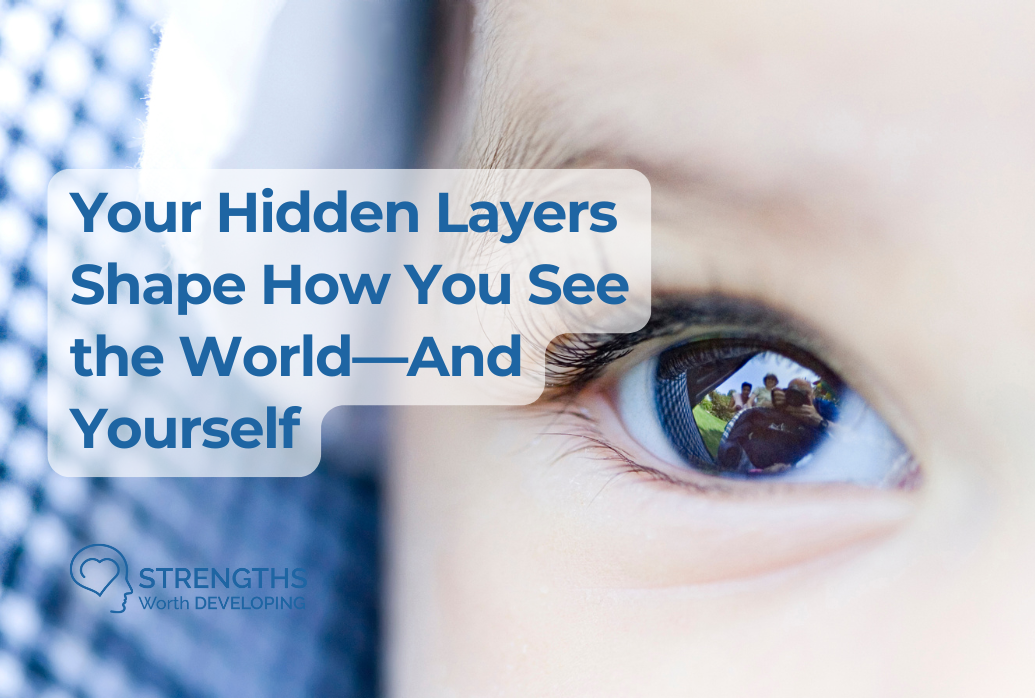Your Hidden Layers Shape How You See the World—And Yourself
Have you ever felt misunderstood, like no one else seems to see the world the way you do? Maybe you’ve faced situations where others reacted in ways that seemed confusing or completely different from how you would respond. Why do some people see opportunity where you see risk? Why does something that brings you joy leave someone else indifferent?
The Lenses You Never Knew You Had
Neuroscientist Robert A. Burton offers a great explanation in his book On Being Certain, using the concept of a hidden layer—a metaphor borrowed from A.I. to describe the unconscious system in our brains that processes information beneath our awareness. Imagine these hidden layers as stacks of lenses, each bending, shaping, and focusing the light of your experiences in unique ways. These lenses are crafted from your biology, life experiences, values, and innate talents.
Just like light passing through different lenses alters how an image appears, your hidden layers filter the raw input of the world around you. This is why two people can experience the same moment so differently—why some are captivated by the rhythm and improvisation of jazz, while others find it chaotic and overwhelming. It’s not the event that differs—it’s the way each person’s unique stack of lenses bends the light of that experience.
How A.I. Really Processes Information—And What That Says About You
In A.I., hidden layers aren’t just mysterious black boxes—they’re where the real magic happens. Each layer transforms input step by step, extracting patterns and making connections that aren’t immediately obvious. Geoffrey Hinton, a pioneer in artificial intelligence, explains that these layers allow AI systems to recognize things like faces, voices, or even the tone of written language—without being directly programmed to do so.
Now, think about your own brain. Every experience you’ve ever had—every memory, every emotion, every lesson learned—adds a layer that shapes how you interpret the world. Like A.I., you don’t consciously control how these layers form or how they process information. They work quietly in the background, helping you recognize patterns, make decisions, and react to situations in ways that often feel instinctive.
Here’s the fascinating part: Just as two A.I. systems—like ChatGPT and Gemini—can process similar inputs through entirely different internal structures and still produce comparable outputs, humans experience something remarkably similar. Two people, each with distinct hidden layers shaped by their strengths, values, and experiences, can approach the same challenge in entirely different ways but still achieve comparable results. One person might rely on quick action and decisiveness, while another takes a more analytical, cautious route. Despite these differing approaches, both can succeed.
While the true depths of our hidden layers often remain inaccessible, tools like CliftonStrengths® and VIA Character Strengths can help point us in the right direction. They offer glimpses into the patterns that might be shaping our thoughts and perceptions, even if we can’t fully uncover them.
Gaining this awareness allows us to make subtle adjustments—bringing clarity, empathy, and a deeper connection to the world around us. It’s a reminder that not everyone will see the world the same way—and that’s not just okay, it’s essential.
Imagine the possibilities when you start recognizing the lenses shaping your experiences. You might make decisions with greater confidence and clarity. Your relationships could become more meaningful and authentic. Communication could improve as you begin to appreciate not just your own perspective, but also how others filter shared experiences through their own unique lenses.The Hidden Layers of Strengths and Character
Your personal lenses aren’t random—they’re shaped by innate talents and values. Tools like CliftonStrengths® and VIA Character Strengths help reveal how those layers filter your perception of the world.
Think of CliftonStrengths® as one set of lenses—focused on how you naturally approach tasks, relationships, and challenges. Someone with Activator might filter experiences through a lens of urgency and action, while a person with Input views the world through curiosity and a need to gather knowledge.
Then there’s VIA Character Strengths, another set of lenses that focuses on your core values and moral compass. A person with Curiosity might be drawn to explore new ideas, while someone with Prudence views decisions through caution and responsibility. These lenses work together, shaping how you interpret situations, build relationships, and respond to challenges.
Adjusting Your Lenses: A Practical Path Forward
If you're ready, here are three steps to start uncovering your hidden layers:
Identify Your Lenses
Begin by discovering your unique combination of talents and values by taking the CliftonStrengths® and VIA Character Strengths assessments to help reveal the lenses shaping your thoughts, actions, and relationships.Reflect on Your Filters
Once you recognize your lenses, take time to reflect on how they influence your perception. How do they affect your decision-making, relationships, and personal goals?Adjust Your Focus
Use your newfound self-awareness to reshape how you connect with others, make decisions, and handle challenges. Understanding your hidden layers empowers you to respond in ways that reflect your true self—enhancing not just how you connect with others, but how you approach challenges, make decisions, and grow.
What You Risk by Ignoring Your Hidden Layers
But what happens if you ignore those hidden layers? The cost isn’t always obvious—but it shows up in subtle, frustrating ways. Misunderstandings linger, relationships remain shallow, and chances for genuine connection slip by. This lack of awareness creates invisible barriers, holding you back from living with clarity, intention, and a true sense of connection—both with yourself and those around you.
While we may never fully grasp the depths of our unconscious processes, we can start to notice recurring patterns—subtle clues that reveal how our hidden layers are influencing us. By tuning into these signals, we don't achieve perfect clarity, but we gain something just as valuable—a deeper understanding of how we engage with the world and how to show up more intentionally in it.

